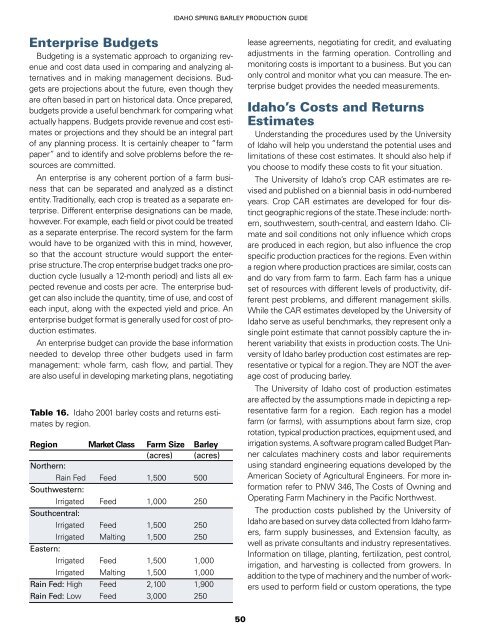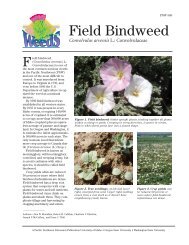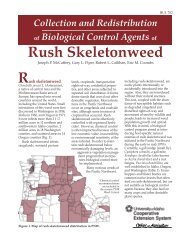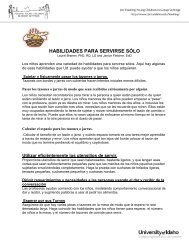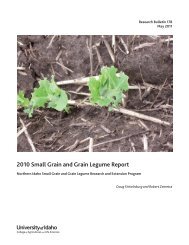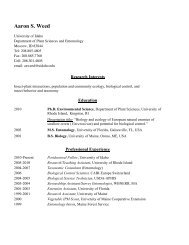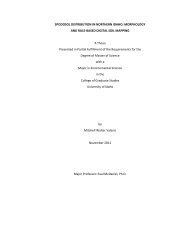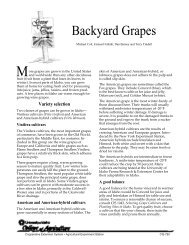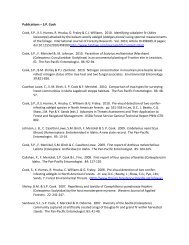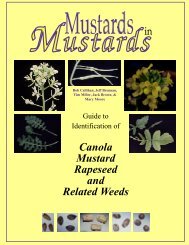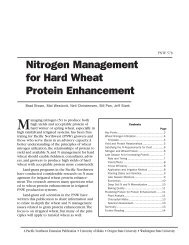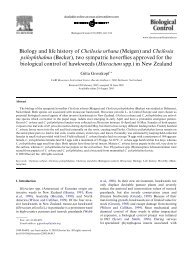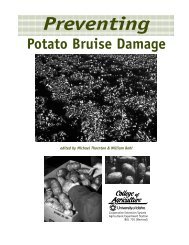Spring Barley Production Guide - College of Agricultural and Life ...
Spring Barley Production Guide - College of Agricultural and Life ...
Spring Barley Production Guide - College of Agricultural and Life ...
You also want an ePaper? Increase the reach of your titles
YUMPU automatically turns print PDFs into web optimized ePapers that Google loves.
Enterprise Budgets<br />
Budgeting is a systematic approach to organizing revenue<br />
<strong>and</strong> cost data used in comparing <strong>and</strong> analyzing alternatives<br />
<strong>and</strong> in making management decisions. Budgets<br />
are projections about the future, even though they<br />
are <strong>of</strong>ten based in part on historical data. Once prepared,<br />
budgets provide a useful benchmark for comparing what<br />
actually happens. Budgets provide revenue <strong>and</strong> cost estimates<br />
or projections <strong>and</strong> they should be an integral part<br />
<strong>of</strong> any planning process. It is certainly cheaper to “farm<br />
paper” <strong>and</strong> to identify <strong>and</strong> solve problems before the resources<br />
are committed.<br />
An enterprise is any coherent portion <strong>of</strong> a farm business<br />
that can be separated <strong>and</strong> analyzed as a distinct<br />
entity. Traditionally, each crop is treated as a separate enterprise.<br />
Different enterprise designations can be made,<br />
however. For example, each field or pivot could be treated<br />
as a separate enterprise. The record system for the farm<br />
would have to be organized with this in mind, however,<br />
so that the account structure would support the enterprise<br />
structure. The crop enterprise budget tracks one production<br />
cycle (usually a 12-month period) <strong>and</strong> lists all expected<br />
revenue <strong>and</strong> costs per acre. The enterprise budget<br />
can also include the quantity, time <strong>of</strong> use, <strong>and</strong> cost <strong>of</strong><br />
each input, along with the expected yield <strong>and</strong> price. An<br />
enterprise budget format is generally used for cost <strong>of</strong> production<br />
estimates.<br />
An enterprise budget can provide the base information<br />
needed to develop three other budgets used in farm<br />
management: whole farm, cash flow, <strong>and</strong> partial. They<br />
are also useful in developing marketing plans, negotiating<br />
Table 16. Idaho 2001 barley costs <strong>and</strong> returns estimates<br />
by region.<br />
Region Market Class Farm Size <strong>Barley</strong><br />
Northern:<br />
(acres) (acres)<br />
Rain Fed<br />
Southwestern:<br />
Feed 1,500 500<br />
Irrigated<br />
Southcentral:<br />
Feed 1,000 250<br />
Irrigated Feed 1,500 250<br />
Irrigated<br />
Eastern:<br />
Malting 1,500 250<br />
Irrigated Feed 1,500 1,000<br />
Irrigated Malting 1,500 1,000<br />
Rain Fed: High Feed 2,100 1,900<br />
Rain Fed: Low Feed 3,000 250<br />
IDAHO SPRING BARLEY PRODUCTION GUIDE<br />
50<br />
lease agreements, negotiating for credit, <strong>and</strong> evaluating<br />
adjustments in the farming operation. Controlling <strong>and</strong><br />
monitoring costs is important to a business. But you can<br />
only control <strong>and</strong> monitor what you can measure. The enterprise<br />
budget provides the needed measurements.<br />
Idaho’s Costs <strong>and</strong> Returns<br />
Estimates<br />
Underst<strong>and</strong>ing the procedures used by the University<br />
<strong>of</strong> Idaho will help you underst<strong>and</strong> the potential uses <strong>and</strong><br />
limitations <strong>of</strong> these cost estimates. It should also help if<br />
you choose to modify these costs to fit your situation.<br />
The University <strong>of</strong> Idaho’s crop CAR estimates are revised<br />
<strong>and</strong> published on a biennial basis in odd-numbered<br />
years. Crop CAR estimates are developed for four distinct<br />
geographic regions <strong>of</strong> the state. These include: northern,<br />
southwestern, south-central, <strong>and</strong> eastern Idaho. Climate<br />
<strong>and</strong> soil conditions not only influence which crops<br />
are produced in each region, but also influence the crop<br />
specific production practices for the regions. Even within<br />
a region where production practices are similar, costs can<br />
<strong>and</strong> do vary from farm to farm. Each farm has a unique<br />
set <strong>of</strong> resources with different levels <strong>of</strong> productivity, different<br />
pest problems, <strong>and</strong> different management skills.<br />
While the CAR estimates developed by the University <strong>of</strong><br />
Idaho serve as useful benchmarks, they represent only a<br />
single point estimate that cannot possibly capture the inherent<br />
variability that exists in production costs. The University<br />
<strong>of</strong> Idaho barley production cost estimates are representative<br />
or typical for a region. They are NOT the average<br />
cost <strong>of</strong> producing barley.<br />
The University <strong>of</strong> Idaho cost <strong>of</strong> production estimates<br />
are affected by the assumptions made in depicting a representative<br />
farm for a region. Each region has a model<br />
farm (or farms), with assumptions about farm size, crop<br />
rotation, typical production practices, equipment used, <strong>and</strong><br />
irrigation systems. A s<strong>of</strong>tware program called Budget Planner<br />
calculates machinery costs <strong>and</strong> labor requirements<br />
using st<strong>and</strong>ard engineering equations developed by the<br />
American Society <strong>of</strong> <strong>Agricultural</strong> Engineers. For more information<br />
refer to PNW 346, The Costs <strong>of</strong> Owning <strong>and</strong><br />
Operating Farm Machinery in the Pacific Northwest.<br />
The production costs published by the University <strong>of</strong><br />
Idaho are based on survey data collected from Idaho farmers,<br />
farm supply businesses, <strong>and</strong> Extension faculty, as<br />
well as private consultants <strong>and</strong> industry representatives.<br />
Information on tillage, planting, fertilization, pest control,<br />
irrigation, <strong>and</strong> harvesting is collected from growers. In<br />
addition to the type <strong>of</strong> machinery <strong>and</strong> the number <strong>of</strong> workers<br />
used to perform field or custom operations, the type


